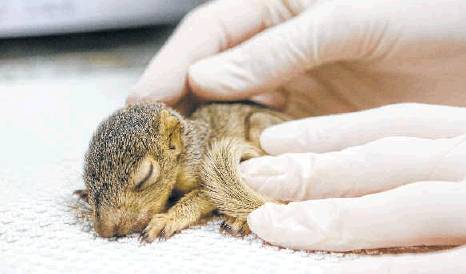Volunteers help clinic care for injured, orphaned animals
By Vincent T. Davis STAFF WRITER
Linda Lamberth has dodged the long, snapping beak of a pelican, grounded at Calaveras Lake. She’s captured a Texas Brown Rat snake from a Floresville home and received a black eye from a Blue Heron.
Ralph Lamberth has slathered canola oil on the heads of skunks to free them from dumpster drain holes. He’s saved a hawk in distress at Braunig Lake and pulled a barred owl from a chimney.
Rescuing all kinds of wild life is a shared passion for this couple, who have been working together at Wildlife Rescue & Rehabilitation since they retired from their respective careers nine years ago.
“I can say with my heart this is a mission I can get behind,” Linda Lamberth, 63, said. “Honestly, all animals want is to be left alone.”
“I love releasing them into the wild, back up in the trees where they should be,” said Ralph Lam-berth, 68, a veteran of the U.S. Air Force who went on to work at Honeywell Inc.
The husband and wife, who have been married 44 years and have no children, have collaborated on several rescues, including slogging through the muddy banks of the San Antonio River to save a lame duck.
The Lamberths have achieved master rescuer designation, working on many of the toughest cases at the Roger & Phyllis Sherman Animal Care Complex in San Antonio. Thursday morning, Wildlife Rescue will celebrate the one-year anniversary of the complex, located at 1354 Basse Rd.
The couple are two of 40 volunteers who have cared for more than 6,000 abused, injured or orphaned animals at the clinic funded by the Kronkosky Charitable Foundation, Roger and Phyllis Sherman and individual donors. They’ve contributed a combined 3,000 volunteer hours in the past seven years; more than 120 people volunteer at the Kendalia location and outlying areas during rescues.
Aleida Fuentes Boles, the wildlife center’s communications and development manager, said the clinic isn’t supported by any government funds and couldn’t function without its volunteer force.
“Volunteers are the heart and soul of this place,” Boles said. “They’re our handy people. That’s why we depend on people like Ralph and Linda to support us.”
Volunteer duties include feeding baby animals, helping animals in need, daily animal transports, cleaning cages, preparing diets, and picking up produce and supplies. For more information about becoming a volunteer, go to http://wildlife-rescue.org/volunteer.
She said 80 percent of the animals are assessed at the San Antonio location before being transported to the Kendalia hospital.
In 1977, founder and president Lynn Cuny began the operation in her San Antonio backyard, caring for wild animals and returning them to their natural habitat.
The nonprofit opened the San Antonio complex on Earl Street in January 2010 as a place where animals could receive immediate care. It soon became clear larger quarters were needed, and in September 2017 Wildlife Rescue moved to its present location.
The Lamberths also were involved in refurbishing the one-story building that serves as a community education center and animal intake facility.
An example of their work can be found in the paved brick circular pattern they designed, cut and laid at the clinic’s entrance.
The building has an additional 7,000 square feet, along with an intake facility, an aviary and a quiet room for baby rabbits, easily stressed and scared.
Their duties extend beyond rescuing injured animals. Recently, Ralph Lamberth strung lights outside for the one-year anniversary, while Linda Lamberth prepared food for baby squirrels.
Clinic manager Kimberly Stephens, who started at the Earl Street location, said people don’t realize how many animals they take in.
“At one point this year, we had more than 250 babies being cared for here,” she said.
Boles said Ralph Lam-berth is known as “Mr. Fix-It,” and Linda Lamberth is the ultimate resource, passing their knowledge and spirit of initiative to trainees.
His love of animals began as a boy in Arkansas, saving fish trapped in dried-up ponds. She grew up in the city with an affinity for creatures without a voice.
Each Friday they report for their shift. And if they’re called out to a rescue, they gear up, slipping on whatever is required to rescue, rehabilitate and release animals back to where they belong.
“There is no magic,” Linda Lamberth said. “You do your best.” vtdavis@express-news.net

